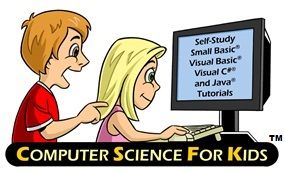It's time for a guest blogger!
Today's guest blogger is Lisa N from Golden Grasses! Her three kids, Feeche (12th grade), Cub (7th grade), and Flower (5th grade) learned it with no programming experience. In Lisa's words...
Having the chance to test drive Beginning Microsoft Small Basic from Computer Science for Kids has been one of the highlights of our spring semester. This is a super easy to use, easy to succeed at, beginning programming course for your homeschool student! I've been looking for something like this for a long time and was not disappointed!
BEGINNING SMALL BASIC PROGRAMMING TUTORIAL
TABLE OF CONTENTS
1. Introducing Small Basic
2. Small Basic Program Basics
3. Your First Small Basic Program
4. Small Basic Program Design, Input Methods
5. Debugging, Decisions, Random Numbers
6. Small Basic Looping, Subroutines
7. More Small Basic Looping, Arrays
8. Small Basic Graphics, Mouse Methods
9. Timers, Animation, Keyboard Methods
10. More Programs
11. Introduction to Advanced Programming Languages
Appendix I. Small Basic Colors
Both Feeche (12th grade) and Cub (7th grade), with no previous programming experience have spent hours delving into this curriculum. After just a few weeks they are both almost done with the first semester, with high hopes of having the 2nd semester available to them soon! Flower (5th grade) started it and has been moving through it at a more reasonable pace, but enjoying it just the same. Cub is farther along then anyone, and occasionally has to ask Feeche for help, but it's simple enough to figure out that they continue moving along at light speed.
Programming is just learning another language, a needed language for the 21rst century, and Computer Science for Kids makes success at computer language acquisition available even for those who have no previous programming experience.
If your kids are like mine, go ahead and purchase both at once; they'll love it, cruise through it, and beg for more! A must have for any conscientious homeschooling family.
3. Your First Small Basic Program
4. Small Basic Program Design, Input Methods
5. Debugging, Decisions, Random Numbers
6. Small Basic Looping, Subroutines
7. More Small Basic Looping, Arrays
8. Small Basic Graphics, Mouse Methods
9. Timers, Animation, Keyboard Methods
10. More Programs
11. Introduction to Advanced Programming Languages
Appendix I. Small Basic Colors
Both Feeche (12th grade) and Cub (7th grade), with no previous programming experience have spent hours delving into this curriculum. After just a few weeks they are both almost done with the first semester, with high hopes of having the 2nd semester available to them soon! Flower (5th grade) started it and has been moving through it at a more reasonable pace, but enjoying it just the same. Cub is farther along then anyone, and occasionally has to ask Feeche for help, but it's simple enough to figure out that they continue moving along at light speed.
Programming is just learning another language, a needed language for the 21rst century, and Computer Science for Kids makes success at computer language acquisition available even for those who have no previous programming experience.
If your kids are like mine, go ahead and purchase both at once; they'll love it, cruise through it, and beg for more! A must have for any conscientious homeschooling family.
Content- excellent
Organization - excellent
Presentation - excellent
Presentation - excellent
